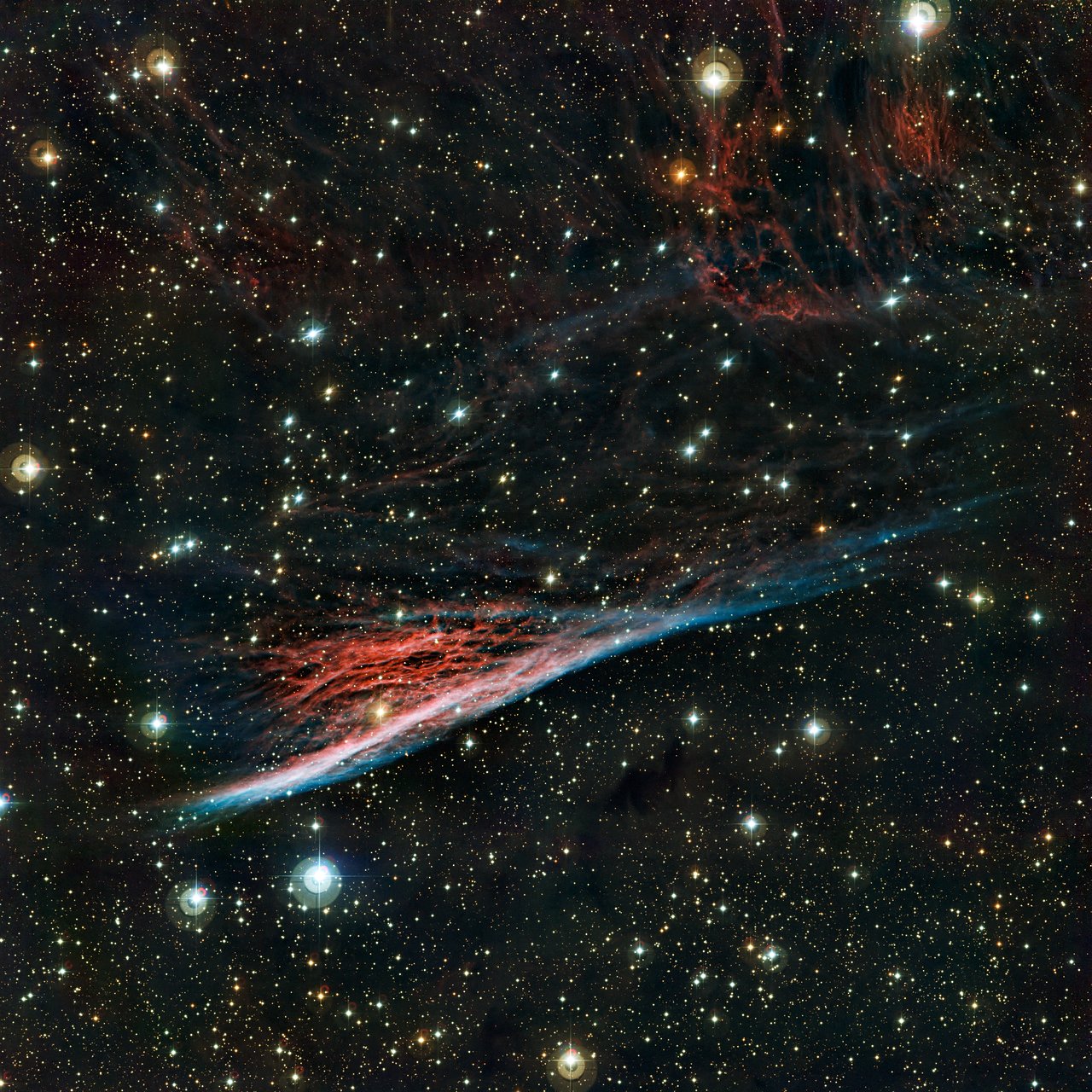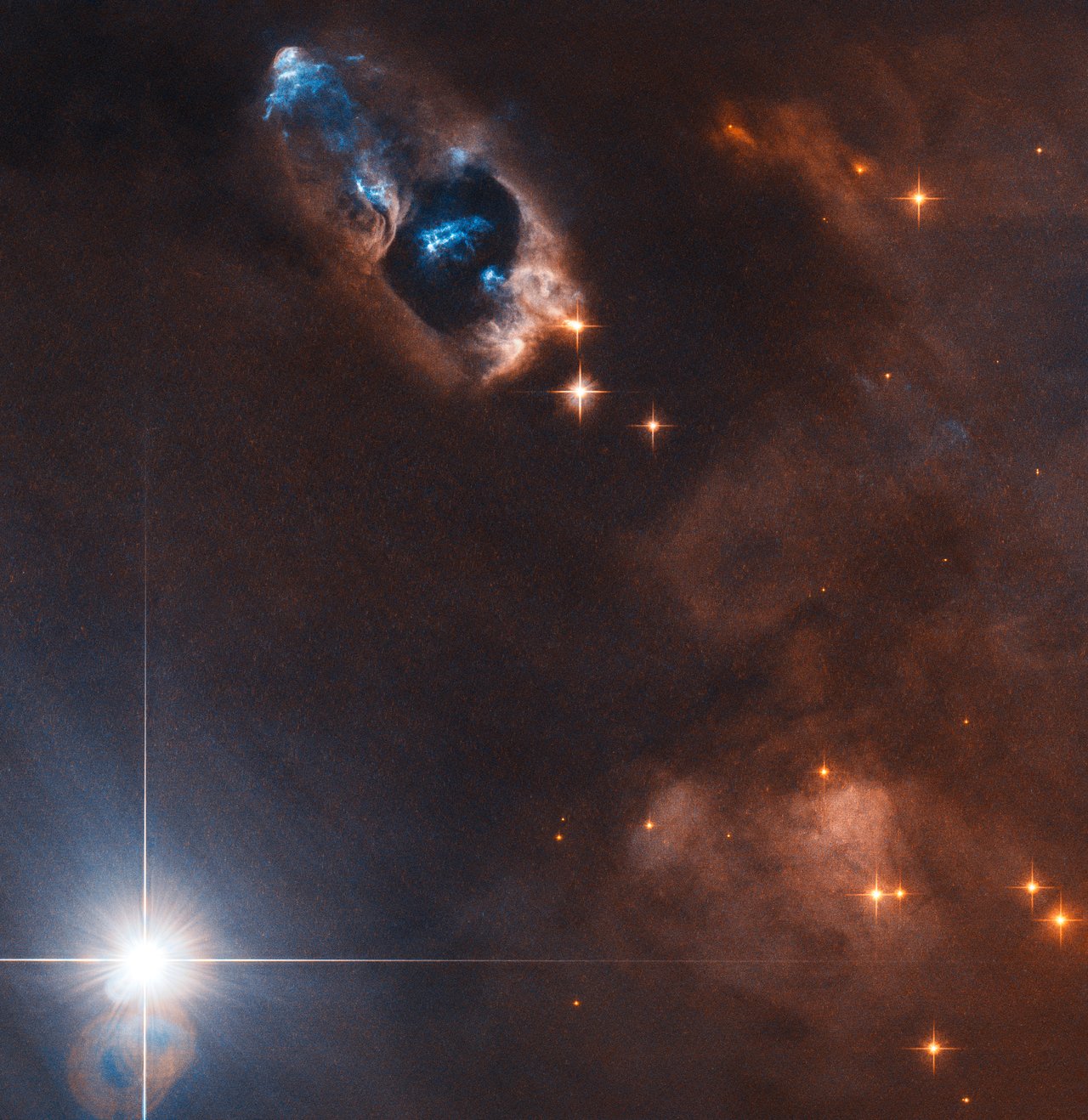Blog
The oddly shaped Pencil Nebula (NGC 2736) is pictured in this image from ESO’s La Silla Observatory in Chile. This nebula is a small part of a huge remnant left over after a supernova explosion that took place about 11 000 years ago. The image was produced by the Wide Field Imager on the MPG/ESO 2.2-metre telescope at ESO’s La Silla Observatory in Chile.

Thetakudi Harihara Vinayakram (born 11 August 1942), also known as Vikku Vinayakram, is the legendary Grammy Award–winning (Planet Drum)Indian percussionist. He plays Carnatic music with the ghatam, an earthen pot, and is credited with popularising the ghatam. He is also known as the God of ghatam.
He was awarded the Padma Shri, given by Government of India in 2002, and later the 2012 Sangeet Natak Akademi Fellowship, the highest honour in the performing arts conferred by the Sangeet Natak Akademi, India’s National Academy for Music, Dance and Drama. Finally he was awarded the Padma Bhushan in 2014.
more...John Anthony Pompeo, better known as Johnny Rae (August 11, 1934 – September 4, 1993), was an American jazz drummer and vibraphonist.
Born in Saugus, Massachusetts, Rae graduated from East Boston High School in 1952 and studied music at the New England Conservatory and at the Berklee College of Music in the early 1950s. His mother was a night club pianist in the Boston area. His first major professional gig was with Herb Pomeroy in 1953-54; following this he played with George Shearing (1955–56), Johnny Smith(1956), Ralph Sharon (1957), Cozy Cole (1957–58), Herbie Mann (1959–60), Cal Tjader (1961–66, 1968–70), Stan Getz (1962), Gábor Szabó, Charlie Byrd, Earl Hines, Art Van Damme, and Barney Kessel. In addition to modern jazz, he also played Latin jazz percussion.
Through the 1980s Rae worked in music education and authored several instruction books. He was also a disc jockey in San Francisco for many years. From 1982 until his passing, Rae led a tribute band called “Radcliffe” in honor of his former bandleader, Cal Tjader. Musicians in the combo included Mark Levine, Robb Fisher, Vince Lateano, Willie Colon, Al Zulaica, Poncho Sanchez, and Dick Mitchell. John was married to Mary Carroll, a San Francisco technical recruiter and author, for three years. He died on September 4, 1993.
more...Eldridge Freeman (August 11, 1921 – 2006), also known as “Buzz” Freeman or “Bruz” Freeman, was an American jazz drummer.
Born in Chicago, with his brothers, guitarist George Freeman and tenor saxophonist Von Freeman, he played for several years in the house band at the Pershing Hotel. He was also the uncle of Chico Freeman, the son of Von Freeman.
In 1950, he was a member of John Young‘s trio with LeRoy Jackson on bass, and recorded with Young’s orchestra backing vocalist Lurlean Hunter.
In the mid-1950s, he was a member of the Hampton Hawes Quartet, with Red Mitchell and Jim Hall, and with line-ups led by Herb Geller. In 1950, with his brothers George and Von (originally misidentified as Claude McLin), LeRoy Jackson, and Chris Anderson, he played with Charlie Parker shortly before his death, at a jam session recorded at Bird’s apartment which was released in 1960 by Savoy. In 1977-8, he joined a short-lived band based in California, led by Kenny Mann and with Britt Woodman on trombone.
more...Waldemar Bastos Memorial
Luanda — Angolan musician Waldemar Bastos died Monday in Lisbon (Portugal) of disease at the age of 66, Angop learned. The information was released by the culture attaché of the Angolan embassy in Lisbon, Luandino de Carvalho, who said Waldemar Bastos had been sick for some time. Waldemar dos Santos Alonso de Almeida Bastos, also known as Waldemar Bastos, was born in M’Banza Kongo, northern Zaire province, on 4 January 1954. The musician started his career very young, having left the country for Portugal after Angola’s independence in 1975. In his 40-year career, Waldemar Bastos was awarded the diploma of founding member of the Angolan Union of Artists and Composers (UNAC-SA) and the World Music Award in 1999. The New York Times in 1999 considered his record “Black Light” as one of the best pieces of its time. In 2018, Bastos was awarded the National Culture and Arts Prize.
more...The Bullet Cluster (1E 0657-56) consists of two colliding clusters of galaxies. Strictly speaking, the name Bullet Cluster refers to the smaller subcluster, moving away from the larger one. It is at a comoving radial distance of 1.141 Gpc (3.72 billion light-years).
Gravitational lensing studies of the Bullet Cluster are claimed to provide the best evidence to date for the existence of dark matter.

Ian Scott Anderson MBE (born 10 August 1947) is a Scottish-born British musician, singer and songwriter best known for his work as the lead vocalist, flautist and acoustic guitarist of British rock band Jethro Tull. Anderson is a multi-instrumentalist who, in addition to flute, plays keyboards, bass guitar, bouzouki, balalaika, saxophone, harmonica, and a variety of whistles. His solo work began with the 1983 album Walk into Light, and since then he has released another five works, including the sequel to the Jethro Tull album Thick as a Brick (1972) in 2012, entitled Thick as a Brick 2.
Ian Anderson was born in Dunfermline, Fife, Scotland, the youngest of three brothers. His father, James Anderson, ran the RSA Boiler Fluid Company in East Port, Dunfermline. Anderson spent the first part of his childhood in Edinburgh. He was influenced by his father’s big band and jazz records and the emergence of rock music, but was disenchanted with the “show biz” style of early American rock and roll stars like Elvis Presley.
His family moved to Blackpool, Lancashire, England, in 1959, where he was educated at Blackpool Grammar School. In a 2011 interview, Anderson said he was asked to leave grammar school for refusing to submit to corporal punishment (permitted at that time). He studied fine art at Blackpool College of Art from 1964 to 1966 while living in Lytham St Annes.
more...Charles H. Israels (born August 10, 1936) is a composer, arranger, and bassist who is best known for his work with the Bill Evans Trio. He has also worked with Billie Holiday, Benny Goodman, Coleman Hawkins, Stan Getz, Herbie Hancock, J. J. Johnson, John Coltrane, and Judy Collins.
Born in New York City, Chuck Israels was raised in a musical family which moved to Cleveland, Ohio when he was 10. His stepfather Mordecai Bauman was a singer who performed extensively with composer Hanns Eisler. He, along with Israels’ mother, Irma Commanday, created a home environment in which music was a part of normal daily activity. Paul Robeson, Pete Seeger, and The Weavers were visitors to the Bauman home. In 1948, the appearance of Louis Armstrong‘s All Stars in a concert series produced by his parents gave him his first opportunity to meet and hear jazz musicians.
In college, Israels had the opportunity to perform with Billie Holiday. His first professional job after college was working with pianist Bud Powell in Paris. His first professional recording was Stereo Drive (aka Coltrane Time) with John Coltrane, Cecil Taylor, Kenny Dorham, and Louis Hayes. The recording showcased Israels as a composer with his composition “Double Clutching”. Israels is best known for his work with the Bill Evans Trio from 1961 through 1966 and for the Jazz Repertory as Director of the National Jazz Ensemble from 1973 to 1981. He made recordings with Kronos Quartetand Rosemary Clooney in 1985. He was the Director of Jazz Studies at Western Washington University in Bellingham, Washington until 2010. In 2011, he created the Chuck Israels Jazz Orchestra and recorded Second Wind: A Tribute to the Music of Bill Evans in 2013. Humphrey Lyttelton, presenting Jazz 625 in 1965, said that Israels was “a superb technician who handles the double bass as easily as if it were a guitar…Chuck Israels is one of the reasons why musicians have come reeling away from performances by the Bill Evans Trio in a mood poised between elation and utter despair.”
more...Gertrude E. “Trudy” Pitts (August 10, 1932 – December 19, 2010) was an American soul jazz keyboardist from Philadelphia, Pennsylvania. She was known primarily for playing the Hammond B3 organ.
Trained as a musician and a music educator, Pitts studied at the Philadelphia Musical Academy, Temple University and Juilliard, as well as other institutions. Early work experience included a position as an assistant to the pianist in the Tony Award-winning musical Raisin.
At the end of the musical’s tour, she was encouraged by her husband (who had worked with Shirley Scott as a drummer) to continue developing her repertoire.
In 1967, the Boston Globe printed a piece calling her a rising star and complimented her drawbar variation, vibrato shadings, and bass pedal work. Her husband, William Theodore Carney II (born 1925), aka “Mr. C.”, often joined her on the drums.
Trudy Pitts eventually went on to play with Ben Webster, Gene Ammons, and Sonny Stitt.[1] She recorded four albums for Prestige Records, appearing with Willis Jackson among others. In 1999, a compilation album of several records was released as Legends of Acid Jazz: Trudy Pitts With Pat Martino. Recent festival appearances include the 11th Annual Mary Lou Williams Women in Jazz Festival at the Kennedy Center in Washington, D.C., in May 2006. On September 15, 2006, Pitts was the first jazz artist to play a concert on Philadelphia’s Kimmel Center’s 7,000 pipe organ, “taking the medium to a whole new level”.
In 2008, she again performed on an exceptional organ, this time the Kennedy Center’s Filene Organ.
Trudy Pitts died on December 19, 2010, aged 78, from pancreatic cancer.
more...Arnett Cleophus Cobb (August 10, 1918 – March 24, 1989) was an American jazz tenor saxophonist, sometimes known as the “Wild Man of the Tenor Sax” because of his uninhibited stomping style. Cobb wrote the words and music for the jazz standard “Smooth Sailing” (1951), which Ella Fitzgerald recorded for Decca on her album Lullabies of Birdland.
Born in Houston, Texas, he was taught to play piano by his grandmother, and he went on to study violin before taking up tenor saxophone in the high school band. At the age of 15 he joined Louisiana bandleader Frank Davis’s band, doing shows in Houston and throughout Louisiana during the summer. Cobb continued his musical career with the local bands of trumpeter Chester Boone, from 1934 to 1936, and Milt Larkin, from 1936 to 1942 (which included a period on the West Coast with Floyd Ray). Among his bandmates in the Larkin band were Illinois Jacquet, Eddie “Cleanhead” Vinson, Tom Archia, Cedric Haywood, and Wild Bill Davis. Having turned down an offer from Count Basie in 1939, Cobb replaced Jacquet in Lionel Hampton‘s band in 1942, staying with Hampton until 1947. Cobb’s featured solo on Hampton’s theme song “Flying Home No. 2” generated much excitement, his blasting style earning him the label “Wild Man of the Tenor Sax”.
Cobb then started his own seven-piece band, but suffered a serious illness in 1950, which necessitated spinal surgery. Although he re-formed the band on his recovery, in 1956 its success was again interrupted, this time by a car crash. This had long-term effects on his health, involving periods in the hospital, and making him permanently reliant on crutches. Nevertheless, Cobb worked as a soloist through the 1970s and 1980s in the U.S. and abroad. As late as 1988 he played with Jimmy Heath and Joe Henderson in Europe. He died in his hometown, at the age of 70 in 1989.
more...In this image the NASA/ESA Hubble Space Telescope has captured the smoking gun of a newborn star, the Herbig–Haro objects numbered 7 to 11 (HH 7–11). These five objects, visible in blue in the top centre of the image, lie within NGC 1333, a reflection nebula full of gas and dust found about a thousand light-years away from Earth.
Herbig-Haro objects like HH 7–11 are transient phenomena. Travelling away from the star that created them, at a speed of up to 250 000 kilometres per hour they disappear into nothingness within a few tens of thousands of years. The young star that is the source of HH 7-11 is called SVS 13 and all five objects are moving away from SVS 13 toward the upper left. The current distance between HH 7 and SVS 13 is about 20 000 times the distance between Earth and the Sun.
Herbig–Haro objects are formed when jets of ionised gas ejected by a young star collide with nearby clouds of gas and dust at high speeds. The Herbig-Haro objects visible in this image are no exception to this and were formed when the jets from the newborn star SVS 13 collided with the surrounding clouds. These collisions created the five brilliant clumps of light within the reflection nebula.

Jack DeJohnette (born August 9, 1942) is an American jazz drummer, pianist, and composer.
An important figure of the fusion era of jazz, DeJohnette is one of the most influential jazz drummers of the 20th century, given his extensive work as leader and sideman for musicians including Charles Lloyd, Freddie Hubbard, Keith Jarrett, Bill Evans, John Abercrombie, Alice Coltrane, Sonny Rollins, Miles Davis, Joe Henderson, Michael Brecker, Herbie Hancock and John Scofield. He was inducted into the Modern Drummer Hall of Fame in 2007.
DeJohnette was born in Chicago, Illinois. He began his musical career as a pianist, studying from age four and first playing professionally at age fourteen. He later switched focus to the drums. DeJohnette credits his uncle, Roy I. Wood Sr., a Chicago disc jockey and vice president of the National Network of Black Broadcasters, as his inspiration to play music.
DeJohnette played R&B, hard bop, and avant-garde music in Chicago. He led his own groups in addition to playing with Richard Abrams, Roscoe Mitchell and other eventual core members of the Association for the Advancement of Creative Musicians (founded in 1965). He also occasionally performed with Sun Ra and his Arkestra (and later in New York as well). In the early 1960s, DeJohnette had the opportunity to sit in for three tunes with John Coltrane and his quintet, an early foray into playing with big-name jazz musicians.
In 1966 DeJohnette moved to New York City, where he became a member of the Charles Lloyd Quartet. A band that recognized the potential influence of rock and roll on jazz, Lloyd’s group was where DeJohnette first encountered pianist Keith Jarrett, who would work extensively with him throughout his career. However, DeJohnette left the group in early 1968, citing Lloyd’s deteriorating, “flat” playing as his main reason for leaving. While Lloyd’s band was where he received international recognition for the first time, it was not the only group DeJohnette played with during his early years in New York, as he also worked with groups including Jackie McLean, Abbey Lincoln, Betty Carter, and Bill Evans. DeJohnette joined Evans’ trio in 1968, the same year the group headlined the Montreux Jazz Festival and produced the album Bill Evans at the Montreux Jazz Festival. In November 1968 he worked briefly with Stan Getz and his quartet, which led to his first recordings with Miles Davis.
https://www.youtube.com/watch?v=sUHAp1vAr8U
more...Edward Rudolph “Butch” Warren Jr. (August 9, 1939 – October 5, 2013) was an American jazz bassist who was active during the 1950s and ’60s.
Warren’s mother was a typist. His father, Edward Sr., was an electronics technician who played piano and organ part-time in clubs in Washington, D.C. The Warren home was often visited by jazz musicians Billy Hart, Jimmy Smith, and Stuff Smith. The first time Butch Warren played bass was at home on an instrument left by Billy Taylor, who had played bass for Duke Ellington. Warren has cited Jimmy Blanton, another Ellington bassist, as his biggest inspiration.
Warren began playing professionally at age 14 in a Washington, D.C. band led by his father. He later worked with other local groups, including that of Stuff Smith, as well as with altoist and bandleader Rick Henderson at the Howard Theatre.
When he was 19, he sat in with Kenny Dorham to substitute for an absent trumpeter. A few days later, Dorham invited him to New York City, where he spent the next six months as a sideman at a club in Brooklyn. He appeared on his first recording in January 1960 with Dorham, saxophonist Charles Davis, pianist Tommy Flanagan, and drummer Buddy Enlow. Through his friendship with Sonny Clark he recorded for Blue Note Records in 1961 on Clark’s album Leapin’ and Lopin’ . Alfred Lion, president of Blue Note, hired Warren to fill the vacancy of staff bassist. During this job he played on “Watermelon Man” with Herbie Hancock. As sideman, he also recorded with Miles Davis, Hank Mobley, Donald Byrd, Dexter Gordon, Joe Henderson, Jackie McLean, and Stanley Turrentine.
Mental illness and heroin addiction created problems for Warren. In 1963, his friend Sonny Clark died of an overdose. Months later, Thelonious Monk hired the 23-year-old Warren. Monk’s band was surrounded by drugs and Warren quit after a yearlong tour. Moving back to D.C., he admitted himself to St. Elizabeths Hospital. He was diagnosed with paranoid schizophrenia.
Following the onset of his illness he played professionally only occasionally, including a regular gig at the jazz club Columbia Station in Washington D.C.
His only solo effort was captured on “Butch’s Blues” but he was better known as a sideman on many albums, including Dexter Gordon’s Go.
more...More Posts
- Charlie Rouse
- Art Taylor
- World Music Offside Trick
- Daily Roots Dub Individual
- Dakini Sky Dancers Blessing 2024
- KARIBUNI Wingspan Life Resources Roseville Lutheran Church
- Temple Israel Erev Shabbat Service
- Cosmos Solar Corona
- Stanley Turrentine
- Nabil Totah
- Billy Bland
- Flamenco Fridays Paco de Lucía y Camarón de la Isla
- Daily Roots Augustus Pablo
- Echoes of Freedom John Lilly
- Cosmos Comet 12P/Pons-Brooks
- Elmer Bernstein
- Hugh Masekela
- Muddy Waters
- World Music Aziza Brahim
- Daily Roots Bob Marley